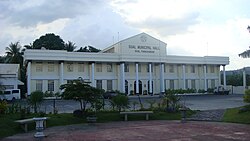Sual | |
|---|---|
| Municipality of Sual | |
 Street in Sual | |
 Map of Pangasinan with Sual highlighted | |
Location within the Philippines | |
| Coordinates: 16°03′54″N120°05′46″E / 16.065°N 120.096°E | |
| Country | Philippines |
| Region | Ilocos Region |
| Province | Pangasinan |
| District | 1st district |
| Founded | May 20, 1805 |
| Barangays | 19 (see Barangays) |
| Government | |
| • Type | Sangguniang Bayan |
| • Mayor | Liseldo D. Calugay |
| • Vice Mayor | Dioneil G. Caburao |
| • Representative | Arthur F. Celeste |
| • Municipal Council | Members |
| • Electorate | 34,338 voters (2025) |
| Area | |
• Total | 130.16 km2 (50.26 sq mi) |
| Elevation | 77 m (253 ft) |
| Highest elevation | 387 m (1,270 ft) |
| Lowest elevation | 0 m (0 ft) |
| Population (2024 census) [3] | |
• Total | 38,625 |
| • Density | 296.75/km2 (768.58/sq mi) |
| • Households | 10,084 |
| Economy | |
| • Income class | 1st municipal income class |
| • Poverty incidence | 22.73 |
| • Revenue | ₱ 469.7 million (2022) |
| • Assets | ₱ 2,645 million (2022) |
| • Expenditure | ₱ 466.5 million (2022) |
| • Liabilities | ₱ 991.4 million (2022) |
| Service provider | |
| • Electricity | Central Pangasinan Electric Cooperative (CENPELCO) |
| Time zone | UTC+8 (PST) |
| ZIP code | 2403 |
| PSGC | |
| IDD : area code | +63 (0)75 |
| Native languages | Pangasinan Ilocano Tagalog |
Sual, officially the Municipality of Sual (Pangasinan : Baley na Sual; Ilocano : Ili ti Sual; Tagalog : Bayan ng Sual), is a municipality in the province of Pangasinan, Philippines. According to the 2024 census, it has a population of 38,625 people. [5]
Contents
- History
- Maritime issues
- Geography
- Barangays
- Climate
- Demographics
- Economy
- Government
- Local government
- Elected officials
- Tourism
- Education
- Primary and elementary schools
- Secondary schools
- Gallery
- References
- External links
It is one of the towns where the Spanish galleon brought their goods to trade. The Philippines largest coal power plant, the 1,200 megawatt Sual Power Station, is located in this municipality. It used to be owned by Mirant Services LLC.










